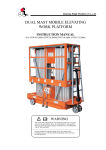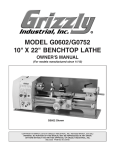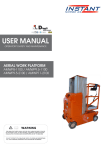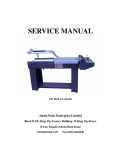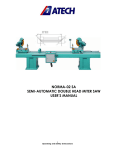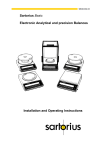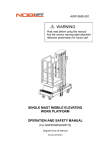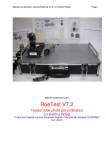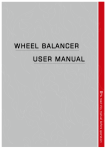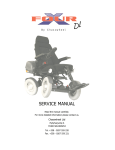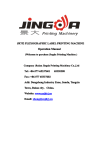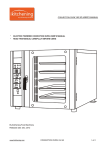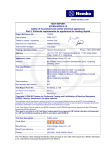Download SINGLE MAST MOBILE ELEVATING WORK
Transcript
R Zhejiang Dingli Machinery Co., Ltd SINGLE MAST MOBILE ELEVATING WORK PLATFORM INSTRUCTION MANUAL (For GTWY6-1000/ GTWY8-1000/GTWY10-1000) W ARNING THE MANUFACTURER SHALL NOT BE HELD LIABLE IN CASE OF FAULTS OR ACCIDENTS DUE TO NEGLIGENCE, INCAPACITY, INSTALLATION BY UNQUALIFIED TECHNICIANS AND IM PROPER USE OF THE M ACHINE DO NOT OPERATE THIS M ACHINE UNTIL YOU READ AND UNDERSTAND ALL THE DANGERS,W ARNINGS AND CAUTIONS IN THIS M ANUAL Contents Chapter 1 Preface……………………………………………………… 1 Chapter 2 Specification………………………………………………… 1 Chapter 3 Safety information………………………………………….. 2 Chapter 4 Plates and Warning Labels………………………………….. 3 Chapter 5 Transport and set up………………………………………… 12 Chapter 6 Operation guide…………………………………………….. Chapter 7 Maintenance guide………………………………………….. 16 Chapter 8 Battery………………………………………………………. 19 Chapter 9 Trouble shooting……………………………………………. 14 20 Chapter 10 Electrical Schematic and Hydraulic diagram……………….. 21 December 2008 Instruction Manual Chapter 1 Preface Read this manual carefully before the machine is taken into use to avoid errors. Correct operations and regular inspections are factors of vital importance for the operating economy and lifetime of the machine. These important parts are described in the following related sections. Alloy aluminum mast mobile elevating work platform is the most ideal equipment for aerial work. Single mast mobile elevating work platform is intended to move one person along with the necessary tools and materials to working position where he will carry out work on the work platform. They are generally intended for use on plane and level floors. They are mainly used for business decoration, industrial facilities maintenance, lamps and lanterns replacement in halls, maintenance of street lamps, aerial photography and wall cleaning etc. The single mast mobile elevating work platform has the following characteristics: 1.1 Lift or fall steadily: The seamless transmission is used between the lifting masts, thus minimizing the amount of sway after lifting. 1.2 Safe and reliable: The four turning stabilizers of the unit connected to the four corners of the chassis support the MEWP during work. They are designed for leveling regulation and preventing inclination. They are composed of stand bars and turning legs. The stand bars are installed in the turning legs. Extending out the turning legs before operating the unit enlarges the area of supporting. Therefore, the steadiness of the whole platform is guaranteed. 1.3 Convenient: The whole work platform is light because the lifting masts are made of alloy aluminum. The structure is compact and the volume is small, so only one person can move the equipment and carry it through a very narrow passage. All the information contained in this booklet is based on the data available at the time of printing; the manufacturer reserves the right to modify its products at any time, without notice and without liability. It is therefore advisable to regularly check for any changes. Chapter 2 Specifications Technical specifications and major dimensions are shown in Table 1 and Figure 1, respectively. Table 1 Model GTWY6-1000 Max. Max. Rated platform working load height height The number of Platform persons size allowed A×B on platform mm mm kg Person(s) 6000 7700 150 1 mm Outrigger footprint C×D mm Power rating AC DC kw Stored dimension L×W×H mm 640×630 1950×1790 0.75~1.5 1.5~1.6 1360×840×1700 Machine weight kg 310 GTWY8-1000 8000 9700 125 1 640×630 2030×1840 0.75~1.5 1.5~1.6 1420×840×2100 330 GTWY10-1000 10000 11700 125 1 640×630 2030×1840 0.75~1.5 1.5~1.6 1420×840×2100 352 DL-GTWY(SINGLE) SERIES page1 December 2008 Instruction Manual 150 H 1100 Figure 1 D B W A L C Chapter 3 Safety information Even if you are familiar with other types of mobile elevating work platforms, read the following matters needing attention for safe and effective operation: 3.1 Only the trained and qualified are permitted to operate this machine. Always use safety belt and helmet when aerially working. 3.2 If you are subject to dizziness or seizures, or are bothered by heights, you must not operate this type of machinery. 3.3 An operator must not use drugs or alcohol that can change his/her alertness or coordination. An operator on prescription or over-the-counter drugs needs medical advice on whether or not he/she can safely operate machines. 3.4 Make sure understand all the safety rules and instructions on plates and warning labels before operating the machine. 3.5 This machine is designed to use on flat and hard ground only. If the ground is uneven, you must adjust supporting bolts to make sure the chassis is on level. Don’t work with force if the conditions for using the equipment are not met. 3.6 Forbid to park the mobile elevating work platform (MEWP) on a slope. When traveling on slope, make sure there are no personnel or obstructions in front of the moving direction. Move at a safe speed. Don’t turn quick on a slope. 3.7 Ensure all stabilizers are engaged properly before elevating the platform. DL-GTWY(SINGLE) SERIES page2 December 2008 Instruction Manual 3.8 In the course of lifting and falling or in lift situation, masts and platform must not collide with any obstacles or moving objects and you must not move it. 3.9 Do not move the whole unit with electricity. 3.10 It is prohibited of getting on and off the work platform when elevated. 3.11 Keep clear of live electric conductors. 3.12 Don’t lift if it is overload. The machine can’t be used as a crane. 3.13 The manual force on the work platform should not exceed 200N. 3.14 Operating this machine should conformance with local national regulations. 3.15 Any unsafe operation patterns on the platform are strictly forbidden. 3.16 Unless in an emergency, the personnel on the ground mustn’t operate the lower control device if they do not receive orders from the one are aerially working. 3.17 Don’t allow people stand or pile up things under the raised platform. 3.18 when operating the machine in a dusty environment,you should take protective measures to prevent the graininess debaris stirred into the moving parts,which can causing damage ,thus extend the span of the machine life 3.19 Don’t change, modify or abandon the safety devices in any way. If there is an uncertain problem, don’t dismantle the machine, inform the dealer for help. 3.20 Don’t set the devices increasing the work height arbitrarily. 3.21 Any additions that would increase the wind load on the machine, e.g. notice boards, are strictly forbidden. 3.22 Any special working methods or conditions beyond those specified by the manufacturer shall obtain the guidance and written approval of the manufacturer. 3.23 The optimal using period is within 5 years, reassess the performance of the machine then and contact the manufacturer for better advice. Chapter 4 Plates and Warning Labels Upon unpacking, check the plates and warning labels. Do not operate the machine on which the plates or labels are missing or illegible. Contact the dealer immediately. The following plates are visible on the machine. ● Nameplate and CE mark DL-GTWY(SINGLE) SERIES page3 December 2008 Instruction Manual ● Operating instructions Brief Operating Instruction ●Leveling the whole equipment 1. Pull up the aligning pin, extend outwards the turning leg, which is connected to one of the four corners of the chassis, until the aligning pin gets into the working aligning hole automatically. 2. Turn the handle clockwise until the supporting foundation contacts the ground for all the four bolts, go on turning to make the road wheel away from the ground. 3. Adjust the leveling by observing the spirit level on the chassis. The bubble should move to the center circle of the gauge when the chassis is set on an even plane. 4. To store the turning stabilizers of the unit, turn the handle counterclockwise until the supporting foundation away from the ground. Pull up the aligning pin, retract inwards the turning leg until the aligning pin gets into the storing aligning hole. ●How to use the control buttons 1. Before operating the machine, all circuit breakers and the leakage breaker must be in “ON” position on the electrical box panel. 2. The mobile elevating work platform uses two sets of upper and lower parallel control devices. 3. On either control panels, press “UP” button for lifting and press “DOWN” button for lowering the platform. 4. The platform rises or falls when the button is pressed. Upon loosening the buttons the platform stops. 5. A big mushroom-shaped button is the stopping button at emergency. Press it only if the platform can’t stop effectively in the course of rising. Reset the button by turning the knob in the direction shown by the arrow. Do not pull the knob. ●Emergency Operation If two sets of the upper and the lower control devices can’t make the platform fall because of sudden power failure or other causes, turn the valve counterclockwise and the platform will be lowered slowly. Once the platform falls down to the bottom, the valve for emergency should be closed. Emergency Operation If two sets of the upper and the lower control devices can’t make the platform fall because of sudden power failure or other causes, turn the valve counterclockwise and the platform will be lowered slowly. Once the platform falls down to the bottom, the valve for emergency should be closed. DL-GTWY(SINGLE) SERIES page4 December 2008 Instruction Manual ●Warning labels DL-GTWY(SINGLE) SERIES page5 December 2008 Instruction Manual DL-GTWY(SINGLE) SERIES page6 December 2008 Instruction Manual DL-GTWY(SINGLE) SERIES page7 December 2008 Instruction Manual DL-GTWY(SINGLE) SERIES page8 December 2008 Instruction Manual DL-GTWY(SINGLE) SERIES page9 December 2008 Instruction Manual GTWY SERIES DECAL INSPECTION(SINGLE) DL-GTWY(SINGLE) SERIES page10 December 2008 Instruction Manual GTWY SERIES DECAL INSPECTION(SINGLE) Part No. 9121011 9121013 9121015 9221011 9321011 9321013 9321015 9323011 9323013 9323015 9323017 9323019 9341011 9421017 9421019 9421021 9421023 9421025 9422011 9422021 9422023 9423011 9423023 9423025 9423027 Description DC control panel Control panel on electric box Control panel on work platform Machinery label Emergency operation Leveling and justment(lift) Leveling and justment(right) Brief operating instruction Gate of platform Label--Down Label--Stop Label—Up Label—Back-up Danger—Collision hazards or Tip-over hazard Caution—Electrocution hazard Warning—Make sure to position the stabilizers before operating Max. Load on each stabilizer—2800N Warning—Turn on the switches.(For AC) Capacity:125kg Warning—Make sure the chock is in place during maintenance Warning—shearing danger, keep hands away Notice—Allowed number of persons: ONE Max. Allowed Manual force—200N Max. Allowed wind speed—10.7m/s Warning—Keeping safe clearance with live electric conductors Caution—The masts or the platform must not bump into any barrier or moving 9423029 object during lifting Warning—Ensure all atabilizers are engaged properly before elevating the 9423031 platform Warning—The manual forces applied by persons on the work platform should 9423033 not exceed the permltted limit when it is raised 9423035 Danger—Any unsafe operation pattern on the platform is strictly forbidden Danger—Don′t move the whole equipment when in the course of lifting and 9423037 lifted Danger—The addition of any device, such as ladder, to increase the working 9423039 height is strictly not allowed. Danger-- Don′t park at the slope, pay attention to the obstacle when moving at 9423041 the slope. 9441011 CE label 9441021 Danger—Please don′t stand 9443015 Warning—Operating Instruction 9443017 Notice—The charging socket of the battery (For DC) 9443019 Notice—Recharging lasts at least 12 hours (For DC) 9443021 Notice—Please cut off the power after operating (For DC) 9443023 Label—Directional arrows Decal Inspection: Use the pictures on the next page to verify that all decals are legible and in place. Below is a numerical list with quantities and descriptions. DL-GTWY(SINGLE) SERIES page11 QTY. 1 1 1 1 1 2 2 1 1 1 1 1 1 1 1 4 4 1 1 1 1 1 1 1 1 1 1 1 1 1 1 1 1 1 1 1 1 1 1 December 2008 Instruction Manual Chapter 5 Transport and set up 5.1 Transport and Storage 5.1.1 Moving the equipment 5.1.1.1The platform should fall down to the bottom when you are moving the equipment to other working places and then retract the turning stabilizers. The supporting foundations should be made away from the ground and then push the whole machine to the destination. If the equipment goes across the uneven ground, the supporting foundations should be away from the ground so far as to prevent the bolt from bending by the obstacles. 5.1.1.2If the platform is carried in a long distance, other loading tools should be used for transportation. A forklift should be used for loading onto other vehicles. It should be lifted upward from the bottom. The sketch below shows the lifting points and method of loading. Note: Pull the plug of the power supply out of the socket when you move the whole equipment, cut off the power supply to avoid any unnecessary accidents. 5.1.2 Storage of the equipment If you plan to stop using the equipment for a long time, the unit should be cleaned and protected by a dustproof cover (supplied). 5.2 Set up 5.2.1 Inspection on Opening the Packaging For the initial use, most users should remove the outer packing of wood box for equipment, shockproof and knock-preventing packing before using the equipment, Even if without outer packing, check the whole equipment and its accessories, and the equipment includes the following parts. DL-GTWY(SINGLE) SERIES page12 December 2008 Instruction Manual Dustproof Cover User’s Manual Certificate of Quality 1–Front Wheel; 2–Chassis; 3–Hydraulic Power Pack; 4–Emergency Lowering Device; 5–Turning Stabilizer; 6–Rear Wheel; 7–Electrical Box; 8–Masts Assembly; 9–Supporting Bars; 10 –Top Cover; 11–Upper Control Device; 12–Guardrail; 13–Platform; 14–Hydraulic Unit Cover; Note: 1.If the unit has been damaged during transport, it must not be put into service, and you should immediately contact your dealer. 2.The equipment has been lubricated before delivery, and the hydraulic unit has been filled with hydraulic oil. 3.If a battery has been supplied with the machine, the battery is charged. Check that the acid level is correct in each cell and that the specific gravity is in order (see “Battery”). 5.2.2 Area Needed For Set up the Machine The area for machine stabilizer footprint shown as the sketch below: C D mm mm GTWY6-1000 1950 1790 2 GTWY8-1000 2030 1840 3 GTWY10-1000 2030 1840 Model 1 D Item C 5.2.3 Supporting and Leveling the Unit There are horizontal forces including operating force and outer wind force etc. on the platform. If excessive, render the platform unstable. Preventing DL-GTWY(SINGLE) SERIES page13 December 2008 Instruction Manual inclination of the unit is achieved by extending the four turning stabilizers, which are connected to the four corners of the chassis. Supporting and leveling the unit is achieved by adjusting the support bolts of the four turning stabilizers. The sketch below shows the following parts: The instructions for operation are as follows: 1.Pull up the aligning pin, extend outwards the turning leg, which is connected to one of the four corners of the chassis, until the aligning pin gets into the working aligning hole automatically. 2.Turn the handle clockwise until the supporting foundation contacts the ground for all the four bolts, go on turning to make the road wheel away from the ground. 3.Adjust the leveling by observing the spirit level on the chassis. The bubble should move to the center circle of the gauge when the chassis is set on an even plane. 4.To store the turning stabilizers of the unit, turn the handle counterclockwise until the supporting foundation gets away from the ground. Pull up the aligning pin, retract inwards the turning leg until the aligning pin gets into the storing aligning hole. Warning! You must observe the spirit level on the chassis. The bubble should be within the center circle of the gauge. Warning! Once you doubt leveling is incorrect, just base on mast and use rectangle level gauge to verify it. Warning! Forbid any operation without extending out all the turning stabilizers. Chapter 6 Operation Guide 6.1 The relevant conditions of using the equipment 6.1.1The surface of work ground should be flat and hard with no obstacles in air and the safety distance between the equipment and high-tension line is adequate. 6.1.2 The environment temperature should be within -10℃~38℃; Height above sea level ≤1000 m. DL-GTWY(SINGLE) SERIES page14 December 2008 Instruction Manual 6.1.3 The environment humidity≤90%. 6.1.4 Electrical power: AC 230V±10%, 50Hz. 6.1.5 The wind power is not more than Beaufort Scale 5 (the speed of wind is 10.7 m/s). 6.1.6 The noise grade of this machine is 72~74 dB while operation. Notes: 1) Prevent the sunlight from directly shining onto the hydraulic and electrical units of the equipment if the environment temperature is above 32℃. 2) If the conditions mentioned above are not met, please contact with your supplier and take the relevant guarantee measures for using the equipment. 6.2 Control Panel function and Description 6.2.1 AC Control Panel 1. Control panel on electric box 2. 3. 4. 5. 6. Circuit breaker Leakage breaker Control circuit breaker Power indicator Up button Down button Control panel on work platform 6.2.2 DC Control Panel 1. Voltage indicator 2. On/Off key 3. Fuse 4. Emergency stop switch 5. Up button 6. Down button 6.3 Installation of Power Plug Put the power plug into the power socket at the job site in accordance with the rated requirement. Note: Prior to installation, the rating of the power source must be confirmed. 6.4 How to use the control buttons 6.4.1 Before operating the machine, all circuit breakers and leakage breaker must be in “ON” position on the electrical box panel DL-GTWY(SINGLE) SERIES page15 December 2008 Instruction Manual 6.4.2 The mobile elevating work platform has two sets of controls; one at the base of the unit and the other on the work platform itself 6.4.3 On either control panels, press “Up” button for lifting and press “Down” button for lowering the platform. 6.4.4 The platform will be raised or lowered so long as the appropriate button is depressed. The platform will stop in position as soon as the button is released. 6.4.5 Emergency stop: A big mushroom-shaped button is provided at each control panel for emergency stop. This should be used only when other means to stop the platform moving fails. Reset the button by turning the knob in the direction shown by the arrow. Do not pull the knob Note: The lower controls is installed on the electrical box, control its key. The key should be taken away if it is not in use so as to prevent the unauthorized personnel from using it. 6.5 Emergency Operation In the event of power cut-off or other reasons and the platform fails to descend using both the upper and lower controls, an emergency device consisting of a release valve located at the side of the chassis is used to lower the platform. Turn the valve counterclockwise and the platform will be lowered slowly. Once the platform has descended to its lowest position, the valve should then be closed securely. Note: The above shows the diagram of the emergency release valve. Chapter 7 Maintenance Guide 7.1 Control check For the initial use or use after long periods of storage or changes in environmental conditions. Check should be made on power supply; hydraulic oils and lubricants to confirm that are all in well condition. Caution! Special attention should be paid to check all safety devices of this machine before using it: 1.Emergency stop switches There are two emergency stop switches on the machine. Please check the function of these two emergency stop switches. Stop to use this machine and inform the manufacturer/agent immediately if they cannot work normally. 2.Emergency release valve There is an emergency release valve on this machine to lower the platform in the event of power cut-off or other reasons and the platform fails to descend using both the upper and lower controls. Please check the function of the emergency release valve. Stop to use this machine and inform the manufacturer/agent immediately if it cannot work normally. DL-GTWY(SINGLE) SERIES page16 December 2008 Instruction Manual 7.2 Check before operation Before you begin your workday, you must inspect your machine and report all deficiencies. Do not operate the machine until deficiencies are corrected and all systems are in good operational condition. 1. Check for missing, damaged or unreadable safety signs. 2. Check for broken, missing, damaged or loose parts, especially the screws and nuts on both sides of the masts. 3. Check pivot pins for damaged or missing retaining devices. 4. Check oil level in the tank. 5. Check hydraulic system for leakage and damage. 6. Check for cracked welds and other evidence of structural damage. 7. Check if the supporting foundations rotate freely around the supporting bolts, lubricate if necessary. 8. Lubricate positions as mentioned in 7.5 if necessary. 9. Check if there is an abnormal noise or tremble when starting the machine. 10. Secure connection of power or battery plug. Perform necessary maintenance procedure outlined by the manufacture. 7.3 Periodical examinations and tests This MEWP should be examined and tested according to the following items every 3 months. 1.Lubricate the lifting chain. Check the chain for wear. 2.Check and tighten possible loose screws and nuts. 3.Check brush wear in the pump motor, and replace those worn so that a good contact is maintained. 4.Visual examination of the structure with special attention to corrosion and other damage of load-bearing parts and welds. 5.Examination of the mechanical, hydraulic, and electrical systems with special attention to safety devices as mentioned in clause 7.1. Note: The frequency and extent of periodical examinations and tests may also depend on national regulations. 7.4 Maintenance 7.4.1Adjusting the maximum rising force The proper pressure of hydraulic system has been preset at the factory, however, the regulating value has been changed because of using the product for a long term. Notes: 1) When you find the rising force not reach the rated value, open the hydraulic DL-GTWY(SINGLE) SERIES page17 December 2008 Instruction Manual unit cover. Please refer to the above sketch, turn the regulating valve 1 of the hydraulic control device clockwise till the rising rated value. 2) If necessary, a pressure gauge (supplied as an optional attachment) could be connected to the emergency lowering valve block for hydraulic system pressure checking. 7.4.2 Adjusting the speed of falling The speed of falling of the platform can also be adjusted. Note: Please refer to above sketch. The speed is reduced when you turn the adjusting screw 2 of “throttle valve ”clockwise, otherwise, the speed is increased. 7.4.3 Fluid level checking A separate fluid level indicator is provided as an attachment (optional) for both the permissible maximum fluid level and the necessary minimum level when the machine is in transports. 7.4.4Replacing the hydraulic oil The hydraulic oil of the equipment should be replaced once after the equipment has been used for half a year to clear off the pollution caused by wearing of the system in the first term. Determine the term of the replacement according to the polluted circumstances of the hydraulic oil later (suggest replacing the hydraulic oil once every one and half one years). Note: 1) Selecting of the hydraulic oil depends directly on influence of the temperature for using. For non-paramo region, the common hydraulic oil of kinematic viscosity (40) 46mm2/s (the nominal value) is recommended for use. 2) When replacing the hydraulic oil, first place a basin for containing waste oil under the oil box. Open the oil filler cap 6 at the top of the oil box and then remove the oil drain plug 5 at the bottom. After draining off the waste oil, fill a little clean hydraulic oil into the oil box through the oil filler hole and wash it. Tighten the drain plug 5 after all the oil has been drained. Then fill up with clean hydraulic oil and allow for a slight overflow to displace any air. 7.4.5 Regulating the transmission chain The direct result of wearing the transmission chain is to stretch the total length of the chain. Measure the stretching rate of the used transmission chain by eye every three months. The mast connected to the elongated chain would be lower in position so that the top of each mast is obviously uneven in ‘stored’ position. It may lead to damage on guide roller if the problem is serious. Note: Every link of the transmission chain is associated with three links of the masts. The following sketch shows the connection of the masts and the transmission chain. 1) When regulating the length of the chain, please select the mast that needs increasing its height. As shown in the sketch, regulating the nut 5 tightly makes the last link of the mast 8 move upwards. The dual nuts 5 should be connected with each other tightly after regulating the length of the chain. DL-GTWY(SINGLE) SERIES page18 December 2008 Instruction Manual 2) The same link of the mast is pulled by two chains and endures the raised weight loads at the same time. If one of the chains loses efficacy, the other will play an important safety role, therefore, try to make both chains as loose or tight as consistent each other when regulating the length of the chain. The methods of judge at site are as follows: Press the two chains by hands to compare their tautness under lifting status. 1-next link of the mast; 2-the middle link of the mast; 3-the transmission chain; 4-adjusting bolt; 5-adjusting lock nut; 6-chainwheel; 7-chainwheel shaft; 8-the last link of the mast Warning! Not to enter the space beneath a raised work platform and extending structure during maintenance unless the chock is in place. Note: When the work platform of a MEWP needs to be raised for routine servicing purposes, a captive chock shall be used to enable the extending structure to be held in the required position to prevent work platform from falling down unexpectedly. Chapter 8 Battery 8.1Battery charging 8.1.1Turn the key and switch on, when the display indicated voltage is below 11 volt, please charge up the battery. 8.1.2The rated specification of the battery charger supplied: Input: 220V AC50/60Hz Output: 12V DC 15A 8.1.3When start charging, insert the output plug of the charger to the charging socket of the chassis first, then the input plug of the charger to the socket of AC power supply. Turn on the charger switch; battery charging is started with indicator (red lamp) lights up. Normal recharging lasts about 10 hours. When DL-GTWY(SINGLE) SERIES page19 December 2008 Instruction Manual charging is terminated check that all cells have reached a density between 1.260~1.280kg/l at 30℃. When charge is finished, the AC supply should be cut off. 8.1.4Battery charging should be done in a well-ventilated place and there are no naked flames, no sparks and no heat radiation sources nearby. 8.1.5Make sure the level of the electrolyte is above the lower line. If the elements are not covered, top up with distilled water. Under normal conditions topping up can be generally done once a month. 8.2Battery maintenance The acid level must be checked at least once a week. Refilling must not take place until charging has been finished, as the acid expands during charging. Only distilled water can be used for refilling. The battery surface must be kept clean and dry, as dirt and wet will cause leakage of current and consequently reduced battery capacity, Acid spill can be neutralized with soda solution or diluted ammonia, which is to be washed off with water. The terminal connections must be firmly tightened and greased with acid-free grease, which prevents sulphate formations. Sulphate coating reduces the contact surface, resulting in a considerable voltage Cautions 1) Before charging, don’t open plugs 2) Charge the battery in a well-ventilated place, lifting off the cover or removing the battery from the machine. 3) Never expose the battery to naked flames. Fires may occur from the formation of explosive gas. 4) Terminal points must be well tightened and free of scale. Cable insulation must be in good condition 5) Keep the battery clean, dry and free dust using an antistatic cloth 6) Never place tools or other metal objects on the battery 7) During recharging, check the temperature of the electrolyte, which must not exceed 45℃ 8) Avoid contact between skin and acid. If skin or clothes come into contact with this acid wash with abundant soap and water. Chapter 9 Trouble shooting Most of the problems you meet with are easy to solve when you are operating on the mobile elevating work platform. Please find out your problems in this part and solve it according to the recommended steps. If you can’t still solve it according to the instructions here, please contact with your suppliers or the experienced service personnel for help. 9.1 Problem 1 –The indicator light of the power supply is off and the platform doesn’t rise or fall. DL-GTWY(SINGLE) SERIES page20 December 2008 Instruction Manual 9.1.1Check whether the electrical wire is connected with the socket of the electricity supply correctly or not. 9.1.2Check the circuit breaker to make sure it’s in ‘ON’ position. 9.1.3Check the leakage breaker to make sure it’s in ‘ON’ position. 9.2 Problem 2 – The power indication light is on, but there is a ‘ticking” sound in the electric box when the ‘UP’ button is pressed and the platform can’t lift or it can only rise up to a limited height. 9.2.1Check the electrical cable to see if it is too long or too thin. The diameter of cable wire should be minimum 1.0 mm when the wire length is less than 25 meters, and minimum 1.5 mm when the wire length is above 25 meters and less than 50 meters. You can try to plug the equipment cord directly in the fixed socket, instead of to an extension cord. 9.2.2Check power voltage to make sure it is within allowable limits. 9.3 Problem 3 – Excessive noise from hydraulic power unit during ‘lifting’ operation. 9.3.1Check oil box to make sure there is sufficient hydraulic oil in the tank. 9.3.2Check whether the oil filler cap is excessively sealed to make the oil pump difficult to absorb the oil or not. 9.3.3Check the mounting screws of the electric motor and cover etc. to see if they have become loose. 9.3.4Check whether the environment humidity is in accordance with the stipulated conditions or not. 9.4 Problem 4 –Leakage of the hydraulic oil 9.4.1Check all piping connections for their tightness, and tighten up if necessary. 9.4.2Check whether the viscosity of the used hydraulic oil is too low or not. 9.5 Problem 5–All the indicator lights are on, but the platform couldn’t rise or fall. Check the Emergency stop switches on both upper and lower control device. Reset the switch by turning the knob in the direction shown by the arrow. Chapter 10 Electric Schematic and Hydraulic Diagram 10.1 Electrical Schematic (next page) DL-GTWY(SINGLE) SERIES page21 December 2008 Instruction Manual 10.1.1 Electrical Schematic of AC power supply DL-GTWY(SINGLE) SERIES page22 December 2008 Instruction Manual AC ELECTRICAL COMPONENTS No. Sign Name Manufacturer Type Parameter Standard Attestation YDP3 10/16A H05VV-F VDE 1 XP1 Battery pin Ningbo Yunhuan Ele.Group Corporation 2 QF1 Breaker ABB GS252S-K/16 16A IEC947-2 CE 3 RCD1 Creepage switch ABB Type ECE Acting current 30mA IEC947-2 CE 4 KM AC contactor Schneidey LC1-0910 AC 24V EN 60947-1 CE 5 HR1 Battery indicator Schneidey XB2-BVM5c 230V EN 60947-5-1 CE 6 M1 Motor Hydr-app M80.4H AC 230V 0.75KW EN 60034-1 EN 60034-5 CE 7 QF2 Breaker ABB GS252S-K/6 6A IEC947-2 CE 8 TC1 transformer JUCHE ELE PRODUCTS JBK5-63 50VA IEC204-1 CE 9 SB1 Emergency stop Schneidey ZB2-BE102c Φ22 EN 60947-5-1 CE 10 SQ1 Stoke switch SCHMERSAL 2V1H 236-112 Φ22 EN 60947-5-1 Annex K CE 11 SBS1 Button switch Schneidey ZB2-BE101c Φ22 EN 60947-5-1 CE 12 SBS2 Button switch Schneidey ZB2-BE101c Φ22 EN 60947-5-1 CE 13 SBS3 Button switch Schneidey ABC-M Φ16 EN 60947-5-1 CE 14 SBS4 Button switch Schneidey ABC-M Φ16 EN 60947-5-1 CE KBU808G 5A — — — DC 24V — CE 15 VC1 Rectifier Shanghai Huajin Rectifier Factory 16 YV1 Solenoid coil Hydr-app DL-GTWY(SINGLE) SERIES page23 December 2008 Instruction Manual 10.1.2 Electrical Schematic of DC power supply DL-GTWY(SINGLE) SERIES page24 December 2008 Instruction Manual DC electrical components S/N Symbol Description/function Model Specification Standard Approval 1 QF1 Circuit breaker DZ47-100 DC 12V 100A EN 60947-2 CE 2 QF2 Circuit breaker DZ47-6 DC 12V, 6A EN 60947-2 CE 3 HL1 Power indicator Y090 DC12V EN 60947-5-1 CE 4 FR1 Overload relay - DC12V 100A EN 60947-4-1 CE 5 SB1 Emergency Stop Button XB2-BS542 ф22 EN 60947-5-1 CE 6 SB2 Emergency Stop Button LA39-11Z/R ф16 EN 60947-5-1 CE 7 SB3 Push Button XB2-BA61 ф22 EN 60947-5-1 CE 8 SB4 Push Button XB2-BA11 ф22 EN 60947-5-1 CE 9 SB5 Push Button LA39-12F/B ф16 EN 60947-5-1 CE 10 SB6 Push Button LA39-11F/W ф16 EN 60947-5-1 CE 11 KA1 Relay amplifier MY2J DC 12V DC 12V IEC 255 CE 12 KM1 DC contactor DK139 DC12V, 100A EN 60947-4-1 CE 13 Yv1 Solenoid - DC 12V CE 14 SQ1 Limit switch 15 M1 Motor 16 G1 Battery 17 SQ2~SQ5 Limit switch - EN 60947-5-1 ZV1H 236-11z 4A/230V AC Annex K EN 60034-1 24009500 DC12V 1.6KW EN 60034-5 CB122000 DC12V 200AH - EN 60947-5-1 AZ17/170-B1 4A/230V AC Annex K 10.2 Hydraulic Diagram 5 3 4 2 1 6 M 1—Hydraulic Power Pack 3—Solenoid Valve 5—Hydraulic Cylinder 2—Emergency Lowering Valve 4— Piping 6—Throttle Valve DL-GTWY(SINGLE) SERIES page25 CE CE CE CE R Zhejiang Dingli Machinery Co., Ltd Address:No.1255 Baiyun South Road, Leidian Town, Deqing, Zhejiang China Tel: 0086-572-8681688 0086-572-8681689 Fax: 0086-572-8681690 E-mail: [email protected] [email protected] Http://www.chinadinli.com




























